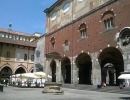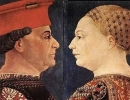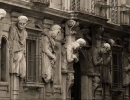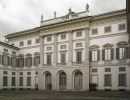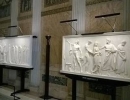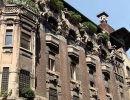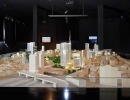THE EVOLUTION OF THE CITY THROUGHOUT THE CENTURIES AND THE ANALYSIS OF ANCIENT MONUMENTS AND NEW BUILDINGS
MILAN IN ROMAN TIMES
Mediolanum
Let’s look for what is left of a city once capital of the Western Roman Empire in the Archeological Museum, rich of prestigious memories, but also in the streets surrounding it, all the way down to the Basilica of San Lorenzo and to the Roman amphitheatre with its Antiquarium.
MILAN IN THE MIDDLE AGE
In a radically transformed city such as Milan (that keeps changing according to times) it is not easy to find monuments and atmospheres of the past centuries. Leaving aside the well known Romanesque and Gothic churches, it is nevertheless still possible to visually recreate the city that in the IX century started its rebirth after the terrible barbaric invasions. Take the Broletto, for instance, with its history of power and trades or the church of San Gottardo in Corte, visible especially for its magnificent brick bell tower just next to the cathedral. To these you should add the Sforza castle, where in the rooms of its museum of Ancient Art, prestigious sculptures, architectonic fragments and frescoes will help us reconstruct the features of a long-gone city.
THE CAPITAL OF THE DUKEDOM
Visconti and Sforza between Middle Age and Renaissance
The Sforza Castle is the symbol of the dukes’ power in Milan throughout two extremely important periods, 14th and 15th century, that saw the turning from the Middle Age to Modern Times. Built as a fortress, only later it would become one of the richest ducal residences of all times. Most of its treasures have unfortunately been destroyed but its history is still visible within its walls and in its rooms that bear traces of the original painted decorations. To the founder of the Sforza dynasty, Francesco Sforza, Milan also owes its first modern hospital, designed by Filarete and immediately nicknamed Ca’ Granda (big house) for its unusual size. Used as a hospital until II world war, it now hosts the Università Statale.
BETWEEN 16TH AND 18TH CENTURY
The palaces and the life of Milanese aristocracy
Private buildings from Mannerism to Neoclassicism. Join an itinerary among central squares and streets to discover Milan and the protagonists of its history, their lifestyle and their habits, led by old town guides.
MILAN UNDER THE RULE OF MARIA TERESA OF AUSTRIA
Renewal and splendours of the Court
The Augsburg’s family, and Maria Teresa of Austria, in particular, brought in Milan a wave of renewal: reforms in the administrative and political management of the city, new urban architectures, development of scientific subjects … Parini and Beccaria did their part socially and culturally-wise, while Piermarini was the architect that turned the city centre into a catalogue of Neoclassical buildings such as Palazzo Reale, Scala, Palazzo Belgioioso, Palazzo Serbelloni, Villa Reale…
A JOURNEY THROUGH 19TH CENTURY AT VILLA REALE
Milan Villa Reale is a rare example of a true villa within the walls of the city: a magnificent residence hidden in the green of its park where the owner used to spend a life of ‘otium’ and entertainment. Presently a museum, its elegant rooms host exceptional collections of 19th century paintings and sculptures.
MODERNISM AND MODERNITY
The “vertically growing city”
Modernity and progress turned 19th century Milan into the ‘moral capital’ of the newly born Italian State; its modern features are mirrored in the early twentieth century art nouveau architecture (also known as Modernism), inspired by nature, in the more stylized Deco, that followed it, down to the thirties with their rationalism, perfectly incarnated in Palazzo di Giustizia (Milan’s Tribunal). To this the vertical growth of the fifties is to be added with buildings such as Torre Velasca and the Pirelli skyscraper.
XXI CENTURY
Renewed suburbs: Bicocca and Bovisa, two cases, two examples
New economy, globalization, a world running at full speed … have deeply changed life in the city and the city itself, including its suburbs, once highly industrialized areas then turned into dens for criminals and homeless. Today these same areas are being given a new growth opportunity, and some of them, such as Bicocca and Bovisa are becoming the new cultural and scientific poles of Milan University.


